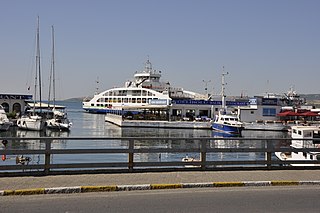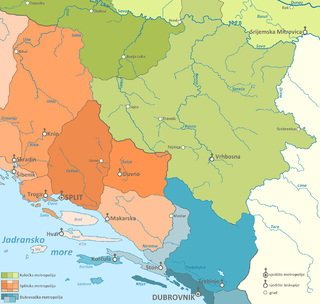Related Research Articles

Gelibolu, also known as Gallipoli, is the name of a town in Çanakkale Province of the Marmara Region, located in Eastern Thrace in the European part of Turkey. It is located on the southern shore of the peninsula named after it on the Dardanelles strait, 3 kilometres (1.9 mi) away from Lapseki on the other shore. It is the seat of Gelibolu District. Its population is 31,782 (2021).

The Roman Catholic Archdiocese of Guadalajara is a Roman Catholic archdiocese based in the Mexican city of Guadalajara, Jalisco. It currently covers an area of 20,827 km². The diocese was erected on July 13, 1548 and was elevated to Archdiocese on January 26, 1863.
Bageis, Bagis (Βάγις), or Bage (Βάγη) was an ancient Greek city in the province of Lydia in Asia Minor.

The Diocese of Cádiz and Ceuta is a Latin Church diocese of the Catholic Church in Spain. The diocese is a suffragan of the Archdiocese of Seville.
Titiopolis or Titioupolis was a town of ancient Cilicia and later in the Roman province of Isauria.
The Diocese of Almería is a Latin Church diocese of the Catholic Church located in the city of Almería in the ecclesiastical province of Granada in Spain.

The Diocese of Guadix is a Latin suffragan diocese of the Catholic Church in the ecclesiastical province of Granada in Andalusia, southern Spain and a Latin titular bishopric under its Ancient name of Acci. Its cathedral episcopal see is Nuestra Señora de la Anunciación, dedicated to Our Lady of the Annunciation, in the city of Guadix, administrative province of Granada. It was commenced in 1710, on the site occupied by the principal mosque, and completed in 1796.
Zaliche or Zaliches (Ζαλίχης) was an ancient town in the late Roman province of Helenopontus.
Aureliopolis in Lydia is a city in the Roman province of Lydia, previously called Tmolus or in Greek Τμῶλος (Tmolos). It issued coinage under each of these names, and one coin combines both names. In the Synecdemus it appears as Auliou Kome. The name "Aureliopolis" was given in honour of the emperor Marcus Aurelius.
Zenopolis was an ancient Roman and Byzantine city in Isauria. Its site is located near Elmayurdu in Asiatic Turkey.

The diocese of Hierapolis, was a Christian bishopric in Phrygia.
The Diocese of Alexandretta is a titular Christian bishopric centred on the town of Alexandretta in Turkey. It is also known as Alexandrinus or Cambysopolis. The bishopric of Alexandria Minor was a suffragan of Anazarbus, the capital and so also the ecclesiastical metropolis of the Roman province of Cilicia Secunda. No longer a residential diocese, Alexandria Minor is today listed by the Catholic Church as a titular see.
Anabura or Anaboura or Anabora (Αναβωρα) may refer to:

Tabuda, Thouda or Tahuda was a Roman–Berber colonia in the province of Numidia. A key town in the Roman, Byzantine and Vandal empires, it is identifiable with the stone ruins at the oasis adjacent to the village of Sidi Okba, Algeria.

The Diocese of Ston was a Roman Catholic diocese in Croatia, located in the city of Stagno. In 1828 it was suppressed to the Archdiocese of Dubrovnik.
The Diocese of Levello was a Roman Catholic diocese in southern Italy, located in the city of Lavello, province of Potenza, in the region of Basilicata. In 1818, it was suppressed, and its territory and members incorporated in the Diocese of Venosa.
The Roman Catholic Diocese of Capri was a Roman Catholic diocese located in the city of Capri on the island of Capri, in the Tyrrhenian Sea off the Sorrentine Peninsula, on the south side of the Gulf of Naples in the Campania region of Italy. On 27 June 1818, it was suppressed to the Archdiocese of Sorrento.
The Diocese of Derbe is an ancient bishopric located at Derbe in the Roman province of Galatia in Asia Minor, and in the ethnic region of Lycaonia. It flourished through the Roman and Byzantine empires, being dissolved on the invasion of the Seljuks at the Battle of Manzikert in 1071. The diocese was nominally refounded as a titular see of the Roman Catholic Church in the 17th century, although the area had never actually been catholic in profession.
The Roman Catholic Archdiocese of Nazianzus is a titular see of the Catholic Church. Both Western Catholic and the Eastern Catholic bishops have been assigned to this diocese. The most famous of which being Saint Gregory of Nazianzus.
References
- ↑ Map 62 (Princeton University Press)
- 1 2 Belke, Klaus; Mersich, Norbert (1990). Tabula Imperii Byzantini Bd. 7. Phrygien und Pisidien. Wien: Österreichicshe Akademie der Wissenschaften. ISBN 3-7001-1698-5 . Retrieved 19 December 2023.
- ↑ Encyclopædia Britannica, 11th edition, "Phrygia"
- ↑ William Smith, Dictionary of Greek and Roman Geography (1854), entry "Anabura"
- ↑ Michel Lequien, Oriens christianus in quatuor Patriarchatus digestus, Paris 1740, Vol. I, coll. 845–846
- ↑ G. Bardy, v. Augustopolis, in Dictionnaire d'Histoire et de Géographie ecclésiastiques, vol. V, 1931, col. 657
- ↑ Annuario Pontificio 2013 (Libreria Editrice Vaticana, 2013, ISBN 978-88-209-9070-1), p. 842